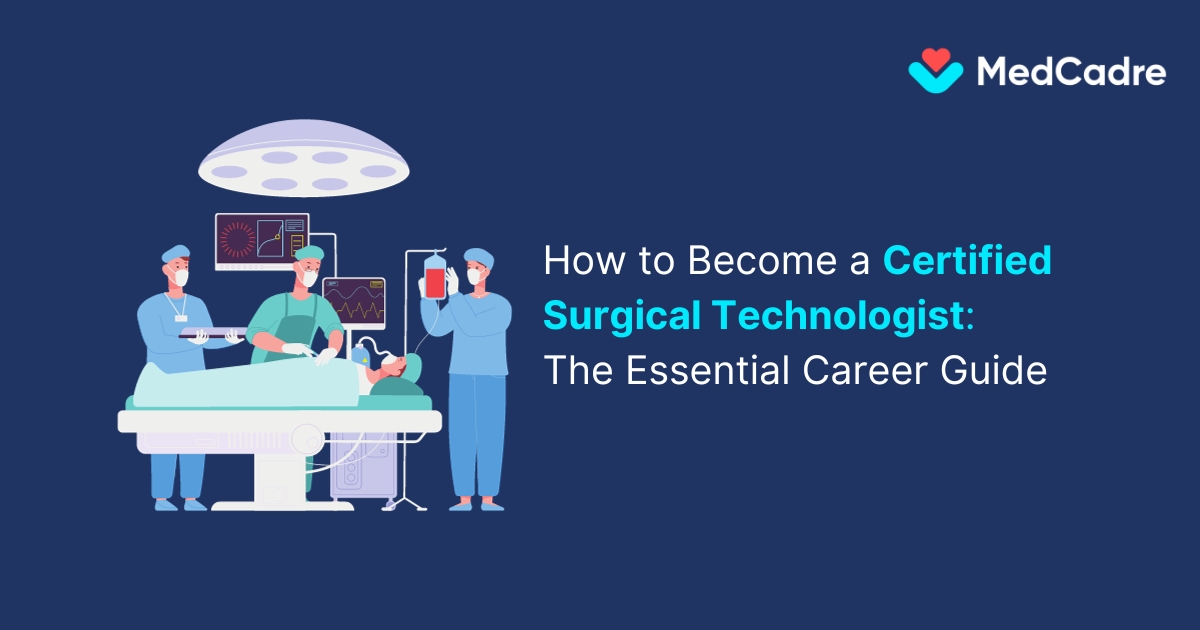If you’re passionate about healthcare and interested in playing a crucial role in the operating room, a career as a Certified Surgical Technologist (CST) might be the perfect fit for you. Surgical technologists are vital members of the surgical team, responsible for ensuring that surgeries are conducted smoothly and safely. This comprehensive guide will walk you through the steps to becoming a certified surgical technologist in the United States.
What is a Certified Surgical Technologist (CST)?
A Certified Surgical Technologist (CST), also known as a scrub tech or operating room technician, is a healthcare professional trained to assist surgeons and nurses in the operating room. CSTs help prepare the surgical environment, sterilize instruments, pass tools to the surgical team, and maintain a sterile field during procedures. Their expertise and attention to detail are essential for the successful and safe completion of surgeries.
Steps to become certified surgical technologists

Step 1: Educational requirements
The first step to becoming a CST is to complete the necessary education. In the United States, this typically involves attending an accredited surgical technology program. These programs are available at community colleges, vocational schools, and some universities.
Here are some key points to consider:
1. Research accredited programs
Start by researching surgical technology programs in your area or online. Ensure that the program is accredited by the Commission on Accreditation of Allied Health Education Programs (CAAHEP) or the Accrediting Bureau of Health Education Schools (ABHES).
2. Prerequisites
Most programs require a high school diploma or equivalent, as well as completion of prerequisite courses in subjects such as biology, anatomy, and physiology.
3. Program length
Surgical technology programs typically take 9 to 24 months to complete, depending on the type of institution and the specific program.
4. Curriculum
The curriculum will cover topics such as surgical techniques, infection control, anatomy and physiology, medical terminology, and sterile processing.
5. Clinical experience
In addition to classroom instruction, you will have to complete a clinical rotation to gain hands-on experience in the operating room.
Step 2: Clinical experience
Clinical experience is a crucial part of your education as a surgical technologist. During this phase, you will work directly in an operating room alongside experienced CSTs and other healthcare professionals. Here’s what you need to know:
1. Hands-on training
Your clinical experience will provide you with valuable hands-on training in a real surgical environment. You’ll assist in various surgeries, learning to set up surgical instruments, create a sterile field, and anticipate the needs of the surgical team.
2. Observation and practice
You’ll have the opportunity to observe and practice under the supervision of experienced professionals. This is the time to ask questions, learn proper sterile techniques, and become familiar with different surgical procedures.
3. Logging hours
Most programs require a specific number of clinical hours to graduate. Be prepared to dedicate a significant amount of time to this phase of your education.
4. Gain proficiency
Use your clinical experience to gain proficiency in surgical technology skills, including aseptic technique, surgical instrument identification, and surgical equipment setup.
Step 3: Certification
Once you’ve completed your education and clinical experience, the next step is to become certified. In the USA, certification is typically achieved through the National Board of Surgical Technology and Surgical Assisting (NBSTSA) or the National Center for Competency Testing (NCCT). Here’s how to go about it:
1. Eligibility
To be eligible for the Certified Surgical Technologist (CST) exam through the NBSTSA, you must have graduated from a CAAHEP- or ABHES-accredited surgical technology program.
2. Study and preparation
Invest time in studying for the certification exam. You can find review materials and practice exams to help you prepare.
3. Exam registration
Once you feel ready, register for the CST exam. The NBSTSA provides information on exam dates, locations, and fees on its website.
4. Take the exam
On the day of the exam, be sure to arrive early, well-prepared, and with proper identification. The CST exam typically consists of 200 multiple-choice questions, and you’ll have four hours to complete it.
5. Passing the exam
After successfully passing the CST exam, you will receive your certification, which is valid for four years. To maintain your certification, you will need to complete continuing education and retake the exam or pass a renewal exam.
Step 4: State requirements and licensing
In addition to national certification, some states may have specific requirements for surgical technologists. It’s important to research your state’s regulations and fulfill any additional requirements, such as obtaining a state license or meeting continuing education obligations.
Step 5: Continuing education
Surgical technology is a dynamic field with constant advancements and evolving best practices. To stay up-to-date and maintain your certification, you’ll need to engage in ongoing education. Here are some considerations:
1. Continuing education units (CEUs)
CSTs are typically required to earn a specific number of CEUs during their certification period. These units can be obtained through seminars, workshops, courses, and conferences related to surgical technology.
2. Professional organizations
Consider joining professional organizations like the Association of Surgical Technologists (AST) to access resources, networking opportunities, and educational events.
3. Renewal exam
Some CSTs choose to renew their certification by retaking the CST exam. This ensures that you stay current with the latest standards and practices in the field.
Step 6: Career opportunities and advancement
As a CST, you’ll have various opportunities to advance in your career. These may include specialization in a particular surgical area (e.g., orthopedics, neurosurgery) or pursuing further education to become a surgical assistant (CSA). Additionally, you can explore roles in supervisory positions, management, education, or research within the healthcare field.
Conclusion
Becoming a Certified Surgical Technologist in the USA is a rewarding journey that requires dedication, education, clinical experience, certification, and ongoing professional development. By following the steps outlined in this guide, you can embark on a fulfilling career in the operating room, contributing to the health and well-being of patients while working alongside a skilled surgical team. Keep in mind that the field of surgical technology is ever-evolving, so continuous learning and dedication to your craft are key to a successful career as a CST.
MedCadre for certified surgical technologists
If you’re ready to take the next step in your healthcare career, consider joining forces with MedCadre, a high-paying healthcare staffing agency. MedCadre offers exciting opportunities for CSTs like you to thrive in the healthcare industry. Their network of top-notch healthcare facilities, excellent compensation packages, and professional support can help you reach new heights in your career.
Don’t miss out on the chance to explore high-paying positions and advance your surgical technology career. Join MedCadre today and unlock the potential for a successful and fulfilling career as a Certified Surgical Technologist. Your future in healthcare begins here!






